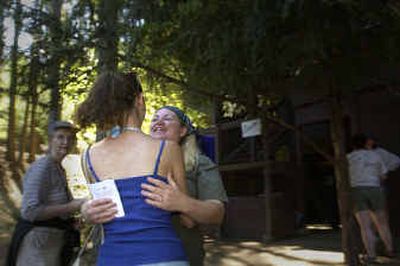Fond memories

This weekend, the Inland Northwest Council of Camp Fire USA’s historic summer camp on Lake Coeur d’Alene held a reunion for camp counselors and other staff members of Sweyolakan and its sister camp, Neewahlu.
You might remember some of these people, mostly women, since the camp didn’t go coed until the 1986. They’re the ones who had a nice tan when school started in the fall and went on to make something of themselves as adults. For them, their fondest childhood memories are of Camp Sweyolakan and the friends they made there for life.
“One of the greatest things about camp was making friends,” said Virginia Harger, 92, who came to Sweyolakan in 1924 and later became camp dietitian. “I loved it from the moment I landed.”
She knows the children and grandchildren of friends she made here who became camp counselors themselves.
“My family didn’t have much,” she said. Before she went to camp summers meant playing baseball with the boys. “Here I learned so much.”
As she spoke in the camp dining hall, a young woman passed by in a bikini. Harger remembers wearing white middies and bloomers, and bathing suits were wool.
The Finney sisters were at the reunion, too. Patricia (Finney) Risser, 65, of Vacaville, Calif., and Judy (Finney) Anderson, 64, of Missoula, first came as campers in the 1940s. Their little sister, Sandy (Finney) Harvego, 62, of Sacramento got to go to camp the next year. They still remember their first impressions of the place.
“It was huge,” Anderson said. “It was totally unspoiled, and it seemed to go on forever.”
She and her sisters remember arriving on Capt. John Finney’s (no relation) barge, the “Dancewanna,” which was pulled by his tug, the “Seeweewanna.” The camp was a welcome relief to the Tri-Cities girls, whose father worked for the Atomic Energy Commission on the Hanford Project.
“We didn’t know what our father did, and our mother wanted us to have a normal experience,” Risser said. During the war years, campers and counselors were asked to bring their wartime rations to help feed the camp.
The camp, which was founded on Mica Bay in 1922 by Kiwanis, had been a hunting lodge. There were no roads, no phones and no boys, at least there weren’t supposed to be.
The camp caretaker discouraged nighttime visits from nearby camp Lutherhaven, which was coed at times, Anderson said. You could tell when Lutherhaven was coed because there were more lights on across the bay. The sisters remember slipping notes in the lunches they made for firefighters when they were battling blazes in the area.
“There was a freedom in not having boys around,” she said. “Girls got to do things the boys and men would,” such as hauling boats or making fires.
At that time, you could camp on virtually any beach because it was mostly government land then. Many girls learned to swim at Sweyolakan. The rule was, you could only go out as far as where the water reached the armpits of the shortest child.
“The better you could swim, the less supervision,” Anderson said. All three sisters worked as camp counselors until 1962. They all attended the University of Idaho, too, because that’s just what Sweyolakan girls did.
The Sweyolakan girls forged friendships that lasted a lifetime. The Finney sisters remember Kitty Kelley, who wore wooden shoes and went on to write “tell-all” books.
“She always knew everything about everybody,” Risser said.
“You talk to any woman out here and they will tell you their days at camp were extremely important to their formative years,” Anderson said.
Of all the counselors and former counselors gathered Saturday, Amanda Larson, 27, of Spokane, has spent the most time at Sweyolakan. She came when she was 6 years old after begging her mother to let her go and joined the staff in 1995.
Ask her what her fondest memories of the camp are and she’ll tell you “mud fights with fourth-graders, the sound of laughter on the water, watching a child learn a new skill or conquer a fear.”
The place is as hard to forget and as easy to return to as a childhood memory.
“Every time I step off the boat I feel like I’m coming home,” Larson said.